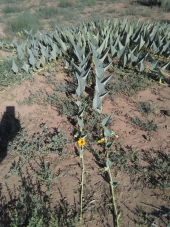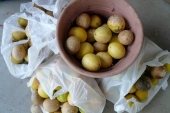posted 7 years ago
Further issues I'd have to overcome:
Most squash and melon grafts are done on seedlings; the rootstock leaves and growing point are removed. In contrast, I'd be grafting onto a stem of an established, multi-stemmed plant with its crown intact. This may lead to several issues: the stems may be hollow, unlike seedling stems (squash stems go hollow at a certain point) and the crown will produce more stems, which would need to be cut off to avoid them swamping the graft.
I'd be working with large, established plants outdoors (since that is the whole point. My early experiments may be done with seedlings in a greenhouse.) This will make graft healing more difficult. Probably only approach grafting, where both plants retain their roots until the graft heals, would work, because small cutting would wither before healing in a field situation. I'd have to start small squash seedlings and transplant them out to the buffalo gourd field, graft, and cut off the top of the buffalo gourd stem and the squash roots latter. Even then, I would probably need a temporary shaded cloche over each to maintain humidity, low light, and higher temperature.
I could probably leave the squash seedling in their starting pots, avoiding the extra step of transplanting. This in and of itself would allow earlier, greater production; squash typically don't transplant well, and I'd be able to start them earlier then transplant seedlings. This might make up for the lost time while the grafts heal.
Squash roots from stems: the squash will probably root themselves into the ground at stem nodes (though this is less likely to happen in my dry climate.) Is this a problem? So long as the initial graft takes, and all sprouts from the buffalo gourd rootstock kept pruned away, they'd still have a big, established root system pumping energy into them; I'd think this advantage would continue, though I'm no expert. In any case, I'd expect much faster initial growth then a seedling could produce.










